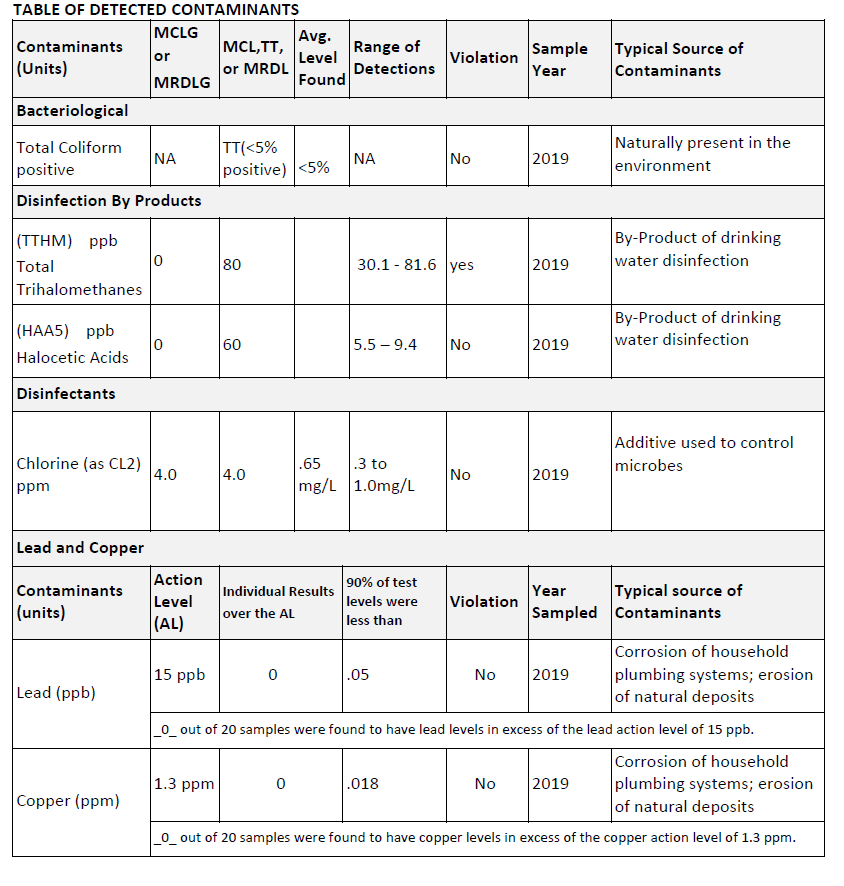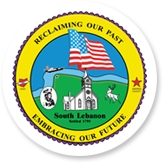2019 CCR
TO DOWNLOAD A PRINTABLE VERSION OF THIS REPORT, PLEASE CLICK HERE.
The Village of South Lebanon
Public Water System
Consumer Confidence Report
Updated March 2019
The Village of South Lebanon
Drinking Water Consumer Confidence Report
2019
The Village of South Lebanon has prepared the following report to provide information to you, the consumer, on the quality of our drinking water. Included within this report is general health information, water quality test results, how to participate in decisions concerning your drinking water and water system contacts.
In 2019 The Village of South Lebanon had an unconditioned license to operate.
The Village of South Lebanon receives 100% of our drinking water from Greater Cincinnati Water Works. A copy of Greater Cincinnati Water Works Consumer Confidence Report is attached to this report or click HERE to download the report.
The sources of drinking water – both tap and bottled – include rivers, lakes, streams, ponds, reservoirs, springs and wells. As water travels over the surface of the land or through the ground, it dissolves naturally occurring minerals (in some cases radioactive material) and can pick up substances resulting from the presence of animals or from human activity. As with all surface waters, the Ohio EPA has classified the Ohio River as highly susceptible to potential contamination. The Ohio EPA has also classified our portion of the Great Miami Aquifer as highly susceptible to contamination due to lack of an overlaying protective clay layer, the presence of low levels of nitrate in the groundwater, and the presence of nearby potential contaminant sources. Copies of the source water assessment report prepared for The Village of South Lebanon are available by contacting the water dept@ 513-494-2296 ext. 1.
The Village of South Lebanon also has an {Auxiliary / Emergency / Back-up} connection with the Warren County Water Department. During 2019 we used __0__ gallons from this connection. On average, this connection is used for approximately __0__ days each year. This report does not contain information on the water quality received from the Warren County Water Department, but a copy of their consumer confidence report can be obtained by contacting Warren County Water Department at 513-695-1377.
What are sources of contamination to drinking water?
Contaminants that may be present in source water include: (A) Microbial contaminants, such as viruses and bacteria, which may come from sewage treatment plants, septic systems, agricultural livestock operations and wildlife; (B) Inorganic contaminants, such as salts and metals, which can be naturally-occurring or result from urban storm water runoff, industrial or domestic wastewater discharges, oil and gas production, mining, or farming; (C) Pesticides and herbicides, which may come from a variety of sources such as agriculture, urban storm water runoff, and residential uses; (D) Organic chemical contaminants, including synthetic and volatile organic chemicals, which are by-products of industrial processes and petroleum production, and can also come from gas stations, urban storm water runoff, and septic systems; (E) Radioactive contaminants, which can be naturally-occurring or be the result of oil and gas production and mining activities.
In order to ensure that tap water is safe to drink, USEPA prescribes regulations which limit the amounts of certain contaminants in water provided by public water systems. FDA regulations establish limits for contaminants in bottled water which must provide the same protection for public health.
Drinking water, including bottled water, may reasonably be expected to contain at least small amounts of some contaminants. The presence of contaminants does not necessarily indicate that water poses a health risk. More information about contaminants and potential health effects can be obtained by calling the Federal Environmental Protection Agency’s Safe Drinking Water Hotline (1-800-426-4791).
Who needs to take special precautions?
Some people may be more vulnerable to contaminants in drinking water than the general population. Immuno-compromised persons, such as persons with cancer undergoing chemotherapy, persons who have undergone organ transplants, people with HIV/AIDS or other immune system disorders, some elderly, and infants can be particularly at risk from infection. These people should seek advice about drinking water from their health care providers. EPA/CDC guidelines on appropriate means to lessen the risk of infection by Cryptosporidium and other microbial contaminants are available from the Safe Drinking Water Hotline (1-800-426-4791).
About your drinking water.
The EPA requires regular sampling to ensure drinking water safety. The Village of South Lebanon conducted sampling for bacteria, Lead and Copper, Chlorine, etc. during 2019. Samples were collected for a number of different contaminants most of which were not detected in the Village of South Lebanon water supply. The Ohio EPA requires us to monitor for some contaminants less than once per year because the concentrations of these contaminants do not change frequently. Some of our data, though accurate, are more than one year old.
Listed below is information on those contaminants that were tested for in the Village of South Lebanon drinking water.

Unregulated Contaminant Monitoring Rule (UCMR) Sampling
Contaminate Average found Range of Detection Year
Total Microcystins 85.1 50-150 2018
Anatoxin-A 87.8 50-150 2018
Cylindrospermopsin 90.2 50-150 2018
Turbidity
See Greater Cincinnati Water Works consumer confidence report for turbidity information.
We are required to monitor your drinking water for specific contaminants on a regular basis. Results of regular monitoring are an indicator of whether or not your drinking water meets health standards. During November, 2019 we (did not monitor or test {or} did not complete all monitoring or testing) for Disinfection Byproducts and Bacteria and therefore cannot be sure of the quality of your drinking water during that time.
Nitrate Educational Information
Nitrate in drinking water at levels above 10 ppm is a health risk for infants less than six months of age. High nitrate levels in drinking water can cause blue baby syndrome. Nitrate levels may rise quickly for short periods of time because of rainfall or agricultural activity. If you are caring for an infant, you should ask advice from your health care provider.
Lead Educational Information
If present, elevated levels of lead can cause serious health problems, especially for pregnant women and young children. Lead in drinking water is primarily from materials and components associated with service lines and home plumbing. The Village of South Lebanon is responsible for providing high quality drinking water, but cannot control the variety of materials used in plumbing components. When your water has been sitting for several hours, you can minimize the potential for lead exposure by flushing your tap for 30 seconds to 2 minutes before using water for drinking or cooking. If you are concerned about lead in your water, you may wish to have your water tested. Information on lead in drinking water, testing methods, and steps you can take to minimize exposure is available from the Safe Drinking Water Hotline at 800-426-4791or at https://www.epa.gov/safewater/lead.
Infants and young children are typically more vulnerable to lead in drinking water than the general population. It is possible that lead levels at your home may be higher than at other homes in the community as a result of materials used in your home’s plumbing. If you are concerned about elevated lead levels in your home’s water, you may wish to have your water tested and flush your tap for 30 seconds to 2 minutes before using tap water. Additional information is available from the Safe Drinking Water Hotline (1-800-426-4791).
How do I participate in decisions concerning my drinking water?
Public participation and comment are encouraged at regular meetings of The Village of South Lebanon which meets every 1st and 3rd Thursday of each month. For more information on your drinking water contact Phil Kaufman or Amy Butler at 513-494-2296
Definitions of some terms contained within this report.
- Maximum Contaminant Level Goal (MCLG): The level of a contaminant in drinking water below which there is no known or expected risk to health. MCLGs allow for a margin of safety.
- Maximum Contaminant level (MCL): The highest level of contaminant that is allowed in drinking water. MCLs are set as close to the MCLGs as feasible using the best available treatment technology.
- Maximum Residual Disinfectant Level (MRDL): The highest level of a disinfectant allowed in drinking water. There is convincing evidence that addition of a disinfectant is necessary for control of microbial contaminants.
- Maximum Residual Disinfectant Level Goal (MRDLG): The level of drinking water disinfectant below which there is no known or expected risk to health. MRDLGs do not reflect the benefits of the use of disinfectants to control microbial contaminants.
- Action Level (AL): The concentration of a contaminant which, if exceeded, triggers treatment or other requirements which a water system must follow.
- Treatment Technique (TT): A required process intended to reduce the level of a contaminant in drinking water.
- Contact Time (CT) means the mathematical product of a “residual disinfectant concentration” (C), which is determined before or at the first customer, and the corresponding “disinfectant contact time” (T).
- Microcystins: Liver toxins produced by a number of cyanobacteria. Total microcystins are the sum of all the variants/congeners (forms) of the cyanotoxin microcystin.
- Cyanobacteria: Photosynthesizing bacteria, also called blue-green algae, which naturally occur in marine and freshwater ecosystems, and may produce cyanotoxins, which at sufficiently high concentrations can pose a risk to public health.
- Cyanotoxin: Toxin produced by cyanobacteria. These toxins include liver toxins, nerve toxins, and skin toxins. Also sometimes referred to as “algal toxin”.
- Level 1 Assessment is a study of the water system to identify the potential problems and determine (if possible) why total coliform bacteria have been found in our water system.
- Level 2 Assessment is a very detailed study of the water system to identify potential problems and determine (if possible) why an E. coli MCL violation has occurred and/or why total coliform bacteria have been found in our water system on multiple occasions.
- Parts per Million (ppm) or Milligrams per Liter (mg/L) are units of measure for concentration of a contaminant. A part per million corresponds to one second in a little over 11.5 days.
- Parts per Billion (ppb) or Micrograms per Liter (μg/L) are units of measure for concentration of a contaminant. A part per billion corresponds to one second in 31.7 years.
- The “<” symbol: A symbol which means less than. A result of <5 means that the lowest level that could be detected was 5 and the contaminant in that sample was not detected.
- Picocuries per liter (pCi/L): A common measure of radioactivity.

